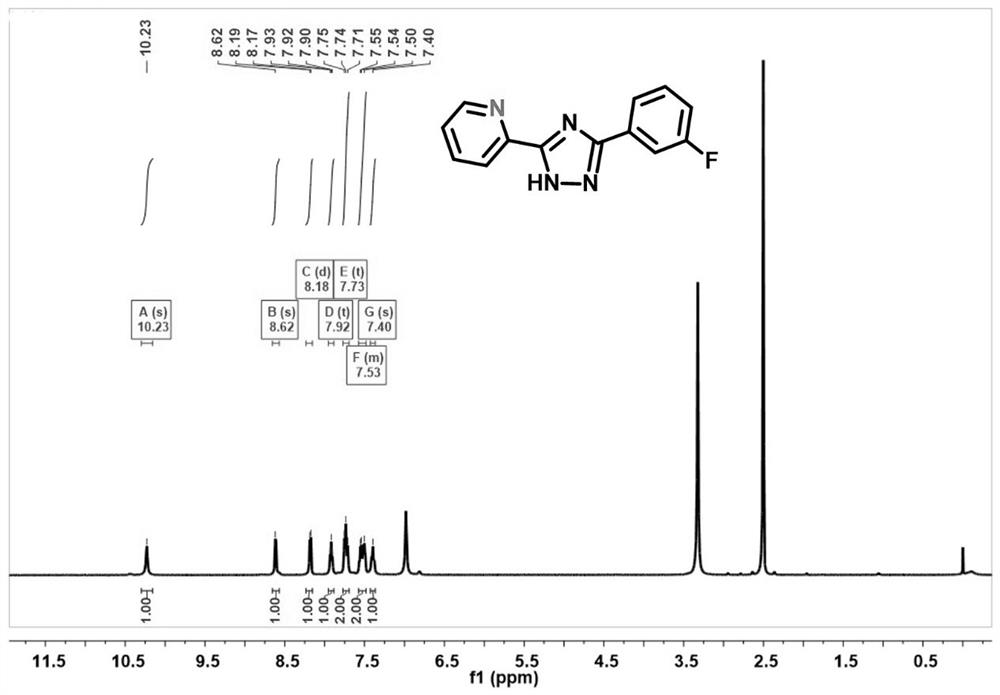Cationic iridium complex as well as preparation method and application thereof
A technology of iridium complexes and cations, applied in the field of biomedicine, can solve problems such as the lack of research on the application of spinal cord injury repair, and achieve the effect of promoting neurite growth, repair, and branch formation
- Summary
- Abstract
- Description
- Claims
- Application Information
AI Technical Summary
Problems solved by technology
Method used
Image
Examples
Embodiment 1
[0046] Example 1 Preparation and Characterization of Cationic Iridium Complex (D79)
[0047] A preparation method of cationic iridium complex, comprising the steps of:
[0048] (1) Synthesis of (pyridin-2-yl)amide hydrazone: 2-cyanopyridine (5.2 g, 0.05 mol) was slowly heated and melted, and then hydrazine monohydrate (2.6 mL, 2.7 g, 0.05 mol) was added to obtain a cloudy mixture. Add ethanol (2.5mL), stir overnight to form a gel-like product, evaporate the solvent under reduced pressure, suspend in petroleum ether (25mL), cool in an ice bath, filter, and purify by recrystallization from toluene to obtain (pyridin-2-yl)amide Hydrazone (5.3g, 77.4%);
[0049] (2) Synthesis of 3FPHtz ligand: Take (pyridin-2-yl)amide hydrazone (1.0g, 7.5mmol), place it in a flame-dried, nitrogen-purged 50mL Schlenk tube, add sodium carbonate (0.8g, 7.5mmol ), heated at 35±2°C for 5 minutes, added 7.5 mL of dry dimethylacetamide (DMAA) and 2.5 mL of dry tetrahydrofuran (THF), then cooled to 0°C ...
Embodiment 2
[0053] Example 2 Research on the Scavenging Ability of D79 to Oxygen Free Radicals
[0054] The free radical scavenging ability of D79 was determined by ABTS method and DPPH method, as follows:
[0055] (1) React ABTS stock solution (5mmol / L, dissolved in PBS) with manganese oxide solution to form ABTS free radicals (ABTS•+);
[0056] (2) Mix different concentrations of D79 with the ABTS radical solution in step (1);
[0057] (3) The absorbance at 734 nm was detected within 120 min using a cell imaging multimode reader (Cytation 5, BioTek Instruments Inc.).
[0058] Test results such as Figure 5 shown. The results showed that D79 significantly inhibited the formation of ABTS free radicals in a time- and dose-dependent manner, indicating that D79 had a high activity of scavenging ROS, so it could be used as an effective free radical scavenger to prevent ROS damage to neurons.
[0059] Furthermore, the in vitro free radical scavenging test of DPPH (1,1-diphenyl-2-pichydrazi...
Embodiment 3
[0060] Example 3 Toxicity of D79 to neuronal cells
[0061] (1) Sprague-Dawley (SD) rat brain hippocampal tissue was taken, added with 0.25% trypsin, and digested at 37°C for 15 minutes;
[0062] (2) After terminating the trypsin action with bovine serum albumin, wash the tissue and grind it gently;
[0063] (3) Seed the isolated hippocampal neurons at a concentration of 20,000 cells / mL in a 35 mm culture dish (Costar, Cambridge, MA) with DMEM medium containing 10% fetal bovine serum and 10% nutrient mixture F-12 (with glutamine, Gibco, Carlsbad, CA, Cat# 12430054) at 37°C, 95% O 2 , 5% CO 2 Cultivate and cultivate in the incubator for 24h;
[0064] (4) Replace the original medium with Neurobasal medium containing 5% B-27 (Gibco), and place at 37°C, 95% O 2 , 5% CO 2 Cultivate in the incubator for 24h;
[0065] (5) After cell adhesion, add different concentrations of D79 to each well and incubate for another 24 hours;
[0066] (6) CCK8 kit (Abnova (Walnut, CA)) was used...
PUM
 Login to View More
Login to View More Abstract
Description
Claims
Application Information
 Login to View More
Login to View More - R&D
- Intellectual Property
- Life Sciences
- Materials
- Tech Scout
- Unparalleled Data Quality
- Higher Quality Content
- 60% Fewer Hallucinations
Browse by: Latest US Patents, China's latest patents, Technical Efficacy Thesaurus, Application Domain, Technology Topic, Popular Technical Reports.
© 2025 PatSnap. All rights reserved.Legal|Privacy policy|Modern Slavery Act Transparency Statement|Sitemap|About US| Contact US: help@patsnap.com



